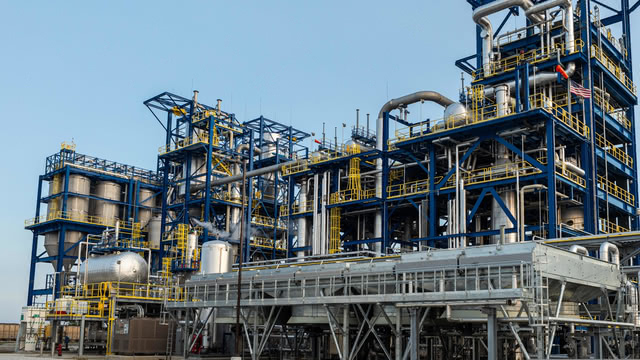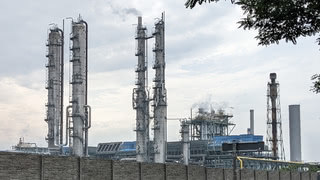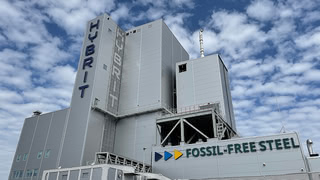The Problem with Turquoise Hydrogen made from Fossil Gas
A process to split methane into its components, hydrogen and carbon, is advertised as a way to make hydrogen from fossil gas without emissions. Yet, claims that methane pyrolysis is free of CO₂ emissions or more efficient than water electrolysis are highly misleading.

While clean hydrogen is currently facing some headways, even critics of the hydrogen hype will usually agree that it has a role to play in reducing emissions in sectors like the steel industry or the production of fertilizers.
Hydrogen is a colorless gas, but in discussions around it, terms like blue, green, or gray hydrogen are regularly used. Those do not refer to any actual color. They are merely naming conventions that refer to different production methods.
Today, the most common way of making hydrogen is steam methane reforming, which utilizes methane from fossil gas. It is often called gray hydrogen and is an emission-intensive process. This current hydrogen production is not a climate solution. It is a significant climate problem.
Green, blue - or turquoise?
Hydrogen can be made by splitting water, a process called electrolysis. If powered by renewable electricity, this is called green hydrogen. While green hydrogen is the cleanest way to make hydrogen if sufficient renewable energy is available, it is currently not produced in meaningful quantities.
An often proposed alternative is combining the production of hydrogen from fossil gas with carbon capture and storage (CSS). It is commonly called blue hydrogen. It is often implied that blue hydrogen provides a faster and cheaper way to scale clean hydrogen production, but that has yet to be shown in practice. Blue hydrogen would only be clean if upstream emissions from fossil gas are low and the carbon capture rate is high.
The only large-scale existing blue hydrogen project, Shell's Quest plant in Canada, only captures a small fraction of its emissions. To achieve high capture rates, it might be necessary to switch to a different technology called autothermal reforming (ATR) that makes carbon capture easier. Retrofitting existing steam methane reforming plants with CCS and high capture rates to make blue hydrogen appears unlikely to be feasible.
While green and blue hydrogen are the clean hydrogen technologies most talked about, there are several ideas for other ways to make hydrogen. One of them is commonly referred to as turquoise hydrogen, also known as methane pyrolysis or methane splitting.
Methane pyrolysis works by exposing methane to high-temperature heat without access to oxygen. This causes a reaction that splits it into its components, carbon and hydrogen. (Pyrolysis is a more generic concept that often appears as a cleantech solution. It can, for example, be used as an advanced plastic recycling method or to make carbon from biogenic inputs like wood. But those other pyrolysis technologies should not be the topic of this text.)
Methane is the main component of fossil gas. Therefore, in its most straightforward form, turquoise hydrogen is still relying on fossil fuels. It would also be possible to utilize biomethane. Unlike traditional steam reforming, methane pyrolysis does not directly produce CO₂. Instead, it produces solid carbon as a "by-product".
I first became aware of the idea of turquoise hydrogen and methane pyrolysis during the early days of the latest hydrogen hype in Germany. Gas industry organizations and companies like BASF and Wintershall Dea pushed the idea that turquoise hydrogen could become one of multiple ways to produce clean hydrogen.
It is important to realize that the role of turquoise hydrogen - and probably more generally the color-coding of the hydrogen rainbow - is not just that of a potential technology. It is also part of a certain story. It is a way to give the impression that clean, climate-neutral hydrogen is not a scarce resource, that the enormous clean energy requirements for any meaningful production of green hydrogen are not a roadblock, and that we shall not shy away from the more controversial hydrogen uses - like hydrogen-ready gas boilers, or hydrogen-powered cars.
"With this idea, the hydrogen car would immediately be the cleanest", Germany's conservative newspaper Welt wrote in an article in 2020, praising the research efforts of BASF and Wintershall Dea. It also mentions that the Russian gas company Gazprom is researching methane pyrolysis in its labs in Tomsk.
In 2019, the German Chemical Industry Association (VCI) published a roadmap for climate-neutral chemistry with a scenario involving 30 percent of future ammonia production based on hydrogen from methane pyrolysis. Yet, more recently, they became more skeptical about such ideas. In updated scenarios published in 2023, VCI writes: "Only methane pyrolysis was no longer included in the scenarios, in view of a reassessment of natural gas as a bridging technology following the Russian war of aggression against Ukraine" (translated from German).
Wintershall Dea, an oil and gas company that was one of the main proponents of methane pyrolysis, no longer exists in its original form. Due to its close ties to Russian companies like Gazprom, the company came into trouble after Russia's attack on Ukraine in 2022. In 2023, its owners - the majority owner was BASF - sold Wintershall Dea's remaining oil and gas assets outside Russia.
BASF still pursues research into the technology, and a BASF spokesperson wrote to me that the research efforts of Wintershall Dea and BASF were entirely independent.
Methane, the Greenhouse Gas
Turquoise hydrogen may have lost some appeal for German industries, but it still comes up regularly, and a number of startups are working on it. Yet, how clean is turquoise hydrogen actually? There are two important issues to consider: methane upstream emissions and the "by-product" carbon.
Methane is a potent greenhouse gas. It causes 27 times as much global warming as an equal amount of carbon dioxide over 100 years and 80 times as much over 20 years. Oil and gas infrastructure emits significant amounts of methane into the atmosphere.
Methane pyrolysis requires more fossil gas input than traditional steam methane reforming per unit of hydrogen. Therefore, if the same fossil gas source is used, upstream emissions for turquoise hydrogen are even higher than for traditional hydrogen production. (The chemical background is that steam reforming also converts water via a water-gas shift reaction to hydrogen, while methane pyrolysis only utilizes the hydrogen atoms from the methane molecules.)
Methane upstream emissions are already reason enough to doubt that turquoise hydrogen is automatically climate-neutral or clean. But there is an even bigger issue: the "by-product" carbon.
Three tons of Carbon per ton of Hydrogen
Methane is a molecule composed of four hydrogen atoms and one carbon atom (CH₄). When splitting those molecules, the carbon obviously does not disappear. While methane pyrolysis is often advertised as a production method for hydrogen, its primary output is carbon. Given that a carbon atom has twelve times the mass of a hydrogen atom, methane splitting generates around three tons of carbon per ton of hydrogen.
Pure carbon has many uses in various industries, so it may be tempting to think that it is a valuable by-product. "The resulting solid carbon can potentially be used in steel or aluminum production, for example", BASF wrote in a press release in 2019. "This methane pyrolysis process requires comparatively little energy. If this energy comes from renewable sources, hydrogen can be produced on an industrial scale without CO₂ emissions."
However, the claim is that one could produce hydrogen "without CO₂ emissions" and, at the same time, "carbon can potentially be used in steel or aluminum production" are incompatible. Of course, carbon used in the steel and aluminum industry also causes CO₂ emissions. After all, those carbon molecules do not disappear if they are sold to another industry.
And this is the core issue. Methane pyrolysis is, first and foremost, not a hydrogen production process with a carbon "by-product". It is the other way round. It is a carbon production process with a hydrogen by-product. If one relies on selling that carbon to other industries that will eventually emit it, not only is it misleading to claim that it's climate-neutral or "without CO₂ emissions", but it is also essentially relying on not decarbonizing those other industries.
(There are residual uses of carbon in some industries that cannot easily be replaced. While most emissions in steelmaking can be avoided by moving to hydrogen-based processes, there are still residual carbon needs. Ideally, processes that require carbon should move to non-fossil carbon sources, e.g., from biogenic sources. Aluminum production uses carbon anodes. Those could be replaced by inert anodes, but that is a technology that appears to be challenging to implement. Yet, those are topics for another time.)
Could carbon from methane pyrolysis be stored indefinitely in a way that does not emit carbon dioxide, for example, by putting it back underground? It is certainly possible, but given the large volumes, it does not appear to be particularly practical.
The largest existing Methane Pyrolysis plant flares its Hydrogen
Currently, only one industrial-scale methane pyrolysis plant is in operation. Olive Creek 1, operated by Monolith, is located in Hallam, Nebraska (USA). It produces carbon black, a special form of pure carbon with a specific structure. Its production capacity for carbon black is 14,000 tons annually. Carbon black is used as a pigment and additive for various plastics and rubber products. Its main use is in tires.
Monolith uses an electric plasma torch to power its high-temperature pyrolysis. That is, on its own, interesting, as it is an example of successful electrification of high-temperature industrial heat. (There is certainly some irony in this fact. High-temperature industrial heat is often named as one of the cases where electrification is infeasible - and, therefore, hydrogen is needed.)
Monolith's plant also produces hydrogen but currently does not use it. In an interview with the Climate Now podcast, Monolith's CEO Rob Hanson said: "For the next few years, we're actually just flaring the hydrogen."
The reason is that hydrogen is "perhaps, the hardest thing in the world to transport", Hansen said in the podcast. Monolith plans to expand its plant and, in the future, wants to build an ammonia plant to utilize its by-product hydrogen. At the current scale, ammonia production is not viable, as the plant would be too small. (Ammonia is a chemical made from hydrogen and is primarily used for the production of fertilizers. Ammonia production is currently the main industrial consumer of hydrogen.)
Traditional production of carbon black is a rather dirty and high-emitting process. It is usually made from coal or oil, and the production causes considerable CO₂ emissions. One may reasonably argue that what Monolith is doing, replacing dirty carbon black with a less-emitting process, is a climate win.
However, it is important to emphasize that it is still carbon black made from fossil fuels. Carbon black is primarily used as an additive in car tires, and old tires are often burned as an energy source. In many cases, the carbon will end up as CO₂ eventually.
Is a wood stove more efficient than a heat pump?
In a video on BASF's web page, the company explicitly advertises methane pyrolysis as an energy-efficient process. "The [...] advantage is that we need much less energy compared to electrolysis - about one-fifth."
Similar claims about energy efficiency can often be found in marketing materials from companies pursuing the technology. Yet, producing hydrogen via methane pyrolysis and requiring just one-fifth of the energy compared to electrolysis is physically impossible.
Elsewhere on BASF's web page, we can find the following more accurate sentence: "Compared to other processes for emission-free hydrogen production, methane pyrolysis requires only around one-fifth as much electrical energy." Notice the small but key difference: they are talking about electric energy.
It is true that making hydrogen via methane pyrolysis requires less electricity than making it from water via electrolysis. It is also unsurprising. Methane is already an energy-rich molecule. Methane pyrolysis is a way of converting one form of chemical energy into another. Electrolysis, on the other hand, is a way of converting electric energy into chemical energy, using low-energy water as its input.
Concluding that a process that requires less electricity but requires other energy inputs is, therefore, more efficient is very misleading. A combustion engine car requires less electricity than an electric car, and a wood stove requires less electricity than a heat pump. Yet, nobody would claim that they are more efficient.
A good use case for Biomethane?
Up until now, we discussed using methane pyrolysis with fossil gas feedstocks. Yet, what about biomethane?
Biogenic materials can be used to produce biogas through anaerobic digestion. It can be upgraded to biomethane, which can be used to replace fossil gas. Biomethane is sometimes also called renewable natural gas (RNG).
The production of biogas and biomethane is, on its own, a complex issue with various controversies, and it is beyond the scope of this article to discuss them in detail. If made from feedstocks like agricultural waste, biomethane can be a climate-friendly resource. Like with any form of bioenergy, as soon as energy crops like corn are involved, land use impacts and other upstream emissions need to be considered. Furthermore, methane emissions can be a problem. The atmosphere does not care whether methane is from biogenic or fossil sources - it always acts as a strong greenhouse gas.
There likely is a place for biomethane in a climate-neutral future. However, given that it is essentially a drop-in replacement for fossil gas, it is very convenient for all kinds of fossil gas users to claim that it may eventually be replaced with biomethane. Unsurprisingly, methane pyrolysis companies also often point to that possibility.
Sustainable biomethane is a limited resource. There needs to be a discussion about where scarce biomethane resources have the biggest impact. Its place is probably not in applications where efficient renewable alternatives exist. Yet, using it as a feedstock for solid carbon products that are otherwise hard to replace - and producing some clean hydrogen as a by-product - certainly does not sound like the worst idea.
It is, therefore, not unreasonable to see a role for methane pyrolysis based on biomethane in a future climate-neutral industry. Yet, it appears unlikely that methane pyrolysis with fossil gas is compatible with climate neutrality. It certainly is not a way to make fantasies of a large-scale supply of cheap, clean hydrogen based on fossil gas happen.
You may also want to read Paul Martin's take on the topic. He was involved in building Monolith's first plant.
Author: Hanno Böck
Brief
-
Waste incinerators are an enormous source of CO2 emissions. The city of Oslo has plans to implement CCS at its Klemetsrud waste incinerator. But last year, they had to put the project on hold due to cost increases. Now, the Norwegian government has granted further financial support for the project, so work may proceed there soon.
-
A fact sheet about hydrogen from Future Cleantech Architects provides a good summary.
-
An article published by Bloomberg looks into methane emissions. Despite pledges and increased visibility of methane emissions through satellite images, emissions are often not reduced.
-
Speaking of methane emissions, and also relevant to the topic of turquoise hydrogen, several environmental organizations are concerned about upcoming EU regulations regarding methane emissions of hydrogen production from fossil gas. A low default value for upstream emissions is not in line with current research, the organizations argue in an open letter.
-
A report for the International Council of Chemical Associations (ICCA) investigates "Pathways for the global chemical industry to climate neutrality".
-
Clariant announces that it will provide a catalyst for a biomass-gasification-to-methanol project in China. (Clariant's press release does not mention which project this is.)
-
Hapag-Lloyd signed an offtake agreement with Goldwind, a Chinese wind energy company, for 250.000 tons of bio- and e-methanol per year.



